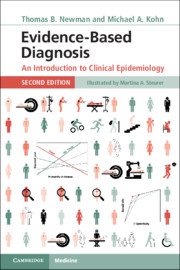Book contents
- Evidence-Based Diagnosis
- Evidence-Based Diagnosis
- Copyright page
- Dedication
- Contents
- Preface
- Acknowledgments
- Chapter 1 Introduction
- Chapter 2 Dichotomous Tests
- Chapter 3 Multilevel and Continuous Tests
- Chapter 4 Critical Appraisal of Studies of Diagnostic Test Accuracy
- Chapter 5 Reliability and Measurement Error
- Chapter 6 Risk Predictions
- Chapter 7 Multiple Tests and Multivariable Risk Models
- Chapter 8 Quantifying Treatment Effects Using Randomized Trials
- Chapter 9 Alternatives to Randomized Trials for Estimating Treatment Effects
- Chapter 10 Screening Tests
- Chapter 11 Understanding P-Values and Confidence Intervals
- Chapter 12 Challenges for Evidence-Based Diagnosis
- Answers to Problems
- Index
- References
Chapter 9 - Alternatives to Randomized Trials for Estimating Treatment Effects
Published online by Cambridge University Press: 02 May 2020
- Evidence-Based Diagnosis
- Evidence-Based Diagnosis
- Copyright page
- Dedication
- Contents
- Preface
- Acknowledgments
- Chapter 1 Introduction
- Chapter 2 Dichotomous Tests
- Chapter 3 Multilevel and Continuous Tests
- Chapter 4 Critical Appraisal of Studies of Diagnostic Test Accuracy
- Chapter 5 Reliability and Measurement Error
- Chapter 6 Risk Predictions
- Chapter 7 Multiple Tests and Multivariable Risk Models
- Chapter 8 Quantifying Treatment Effects Using Randomized Trials
- Chapter 9 Alternatives to Randomized Trials for Estimating Treatment Effects
- Chapter 10 Screening Tests
- Chapter 11 Understanding P-Values and Confidence Intervals
- Chapter 12 Challenges for Evidence-Based Diagnosis
- Answers to Problems
- Index
- References
Summary
We said in Chapter 8 that randomized blinded trials are the best way to estimate treatment effects because they minimize the potential for confounding, co-interventions, and bias, thus maximizing the strength of causal inference. However, sometimes observational studies can be attractive alternatives to randomized trials because they may be more feasible, ethical, or elegant. Of course, the issue of inferring causality from observational studies is a major topic in classical risk factor epidemiology. In this chapter, we focus on observational studies of treatments rather than risk factors, describing methods of reducing or assessing confounding that are particularly applicable to such studies.
- Type
- Chapter
- Information
- Evidence-Based DiagnosisAn Introduction to Clinical Epidemiology, pp. 231 - 249Publisher: Cambridge University PressPrint publication year: 2020



